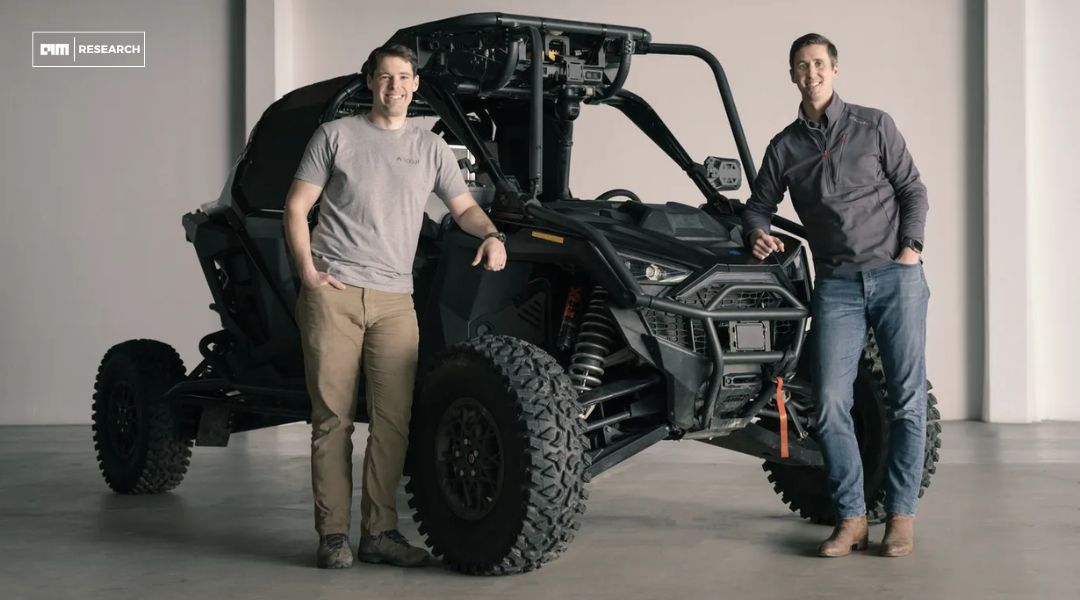

Scout AI didn’t begin with the usual startup pitch deck or consumer-facing app. It began with a conviction that future military strength won’t be measured solely by troops or machines, but by how effectively humans and intelligent systems operate as a team. That idea, formed by founders Colby Adcock and Collin Otis, took shape in August 2023 and has now emerged in public view with $15 million in seed funding and a defense-first artificial intelligence model they’ve named Fury.
Based in Sunnyvale, California, Scout AI is building what it calls the robotic foundation model for defense not just smarter drones or vehicles, but AI that can think, interpret, and act like a soldier. At the heart of its work is Fury, a Vision-Language-Action (VLA) model engineered to perceive the real world, understand natural language instructions, and issue motor commands to robotic platforms. The model is already powering Scout’s own autonomous ground and aerial vehicle prototypes the G01 and A01 at a testing site in the Santa Cruz Mountains. Both systems are operating autonomously and designed to function in the types of high-stakes, low-connectivity environments common in modern warfare.
Scout’s approach isn’t just about building new machines. It’s about upgrading existing ones. The company has developed Fury to be modular and hardware-agnostic, capable of running on commercial off-the-shelf components. According to Otis, this enables rapid integration across a wide range of robotic systems air, land, sea, or space without requiring custom hardware. In essence, Scout aims to make the robots the military already has significantly more capable.
“Physical AI is the most decisive military advantage of the century,” Adcock said. “Our vision is one warfighter commanding many robots, seamlessly integrated into a unified team.” That level of coordination, he added, demands an AI brain that can interpret commander intent and act with the situational awareness of a seasoned operator.
The seed round, announced Wednesday, was led by Align Ventures and Booz Allen Hamilton’s corporate venture capital arm. Booz Allen, which has been increasing its investment in defense AI startups, sees Scout’s system as an opportunity to modernize legacy robotic systems and extend autonomous capabilities across military platforms. “Scout AI’s approach to autonomy enables versatile robotic systems that better handle the long tail of edge cases present on the battlefield while also offering a more human-centric user experience for robotic control,” said James Gadea of Booz Allen Ventures.
That human-centric experience is central to the company’s pitch. Fury allows warfighters to issue text or voice-based commands and receive intelligent responses — a shift from button-press control systems to natural-language-driven interaction. “This is the kind of force projection that will ultimately deter future conflict,” said Adcock. “Every branch of the military faces the same fundamental challenge: how to deploy robots at scale.” According to Scout, that challenge isn’t just about logistics, it’s about intelligence. Robots need to understand missions, context, and goals, even in GPS- and comms-denied environments.
Scout’s team is pulling talent from the self-driving world, defense contractors, and big tech to build what it calls “the AI brain” for autonomous defense systems. The company says it is working with a growing list of robotics companies to integrate Fury into their platforms, with the goal of enabling intelligent autonomy without requiring full system overhauls.
The funding round, which was oversubscribed, included participation from Draper Associates, Decisive Point Ventures, Perot Jain, Sigmas Group, Evolution VC, BVVC, Habitat Partners, Piedmont Capital Investments, FJ Labs, Revelry Venture Partners, Monte Carlo Capital, Expansion VC, and Gaingels.
For Booz Allen, the investment continues a pattern. The firm recently backed Shield AI’s F-1 round to expand deployment of its Hivemind platform and has collaborated with Carnegie Robotics on co-development work. “Scout AI’s technology will play a pivotal role in outpacing emerging threats with the realization of uncrewed systems, specifically in communications-constrained environments,” said Randy Yamada, a vice president at Booz Allen Hamilton.
📣 Want to advertise in AIM Research? Book here >
Cypher 2024
21-22 Nov 2024, Santa Clara Convention Center, CA
A Vendor Briefing is a research tool for our industry analysts, and an opportunity for a vendor to present its products, services and business strategies to analysts who cover the vendor specifically or a related technology or market.
AIM Research encourages technology vendors and agencies to brief our team for PeMa Quadrants, when introducing a new product, changing a business model, or forming a partnership, merger, or acquisition.


